 A buttonhook is a tool used to facilitate the closing of buttoned shoes, gloves or other clothing. It consists of a hook fixed to a handle which may be simple or decorative as part of a dresser set or chatelaine. Sometimes they were given away as promotions with product advertising on the handle. To use, the hook end is inserted through the buttonhole to capture the button by the shank and draw it through the opening.
A buttonhook is a tool used to facilitate the closing of buttoned shoes, gloves or other clothing. It consists of a hook fixed to a handle which may be simple or decorative as part of a dresser set or chatelaine. Sometimes they were given away as promotions with product advertising on the handle. To use, the hook end is inserted through the buttonhole to capture the button by the shank and draw it through the opening.Buttonhooks are probably as old as buttons themselves but certainly from the mid-Victorian era until just after World War I, no home was without a selection of buttonhooks and most people, both men and women carried one with them. Ladies boots at the time could have around 50 buttons on each boot, so a button hook was a necessary item.
It was not only boots, because jackets, waistcoats, ladies gloves, Scottish soldier's spats, a tight leather boot, a dress with a row of buttons and even corsets were held together with buttons, all of them small, fiddly and almost impossible to fasten with one's fingers required the use of the buttonhook. A lady nurse wearing a chatelaine including useful household tools such as a buttonhook.
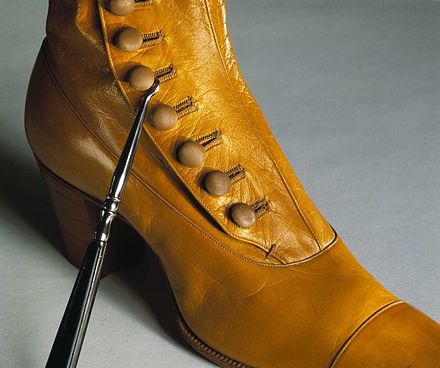 The Victorian love of innovation led to the production of a great variety of tools and gadgets designed to make life simpler and to highlight the sophistication and refinement of the owner. One of these tools was the buttonhook. Although almost unknown now, back in the 1890s it was a common household tool. The earliest known reference to the buttonhook was in 1611: 'Boutonneur: A Buttoner; or an instrument wherewith buttons are pulled through their o'er-strait holes.' Both the Victorians and Edwardian could not stop themselves from altering the basic design and as a direct result, button hooks come in all shapes and sizes that reflects the fashion of the times and the creativity of the inventor.
The Victorian love of innovation led to the production of a great variety of tools and gadgets designed to make life simpler and to highlight the sophistication and refinement of the owner. One of these tools was the buttonhook. Although almost unknown now, back in the 1890s it was a common household tool. The earliest known reference to the buttonhook was in 1611: 'Boutonneur: A Buttoner; or an instrument wherewith buttons are pulled through their o'er-strait holes.' Both the Victorians and Edwardian could not stop themselves from altering the basic design and as a direct result, button hooks come in all shapes and sizes that reflects the fashion of the times and the creativity of the inventor.Design
As a gadget, the button hook was simplicity itself. Basically it comprises a steel shank or prong of varying length with a little hook on one end and a handle on the other. The prong was inserted through the button hole and the hook positioned around the shank of the button. With a swift tug and a deft twist of the wrist and the button was pulled easily into place to do its duty.
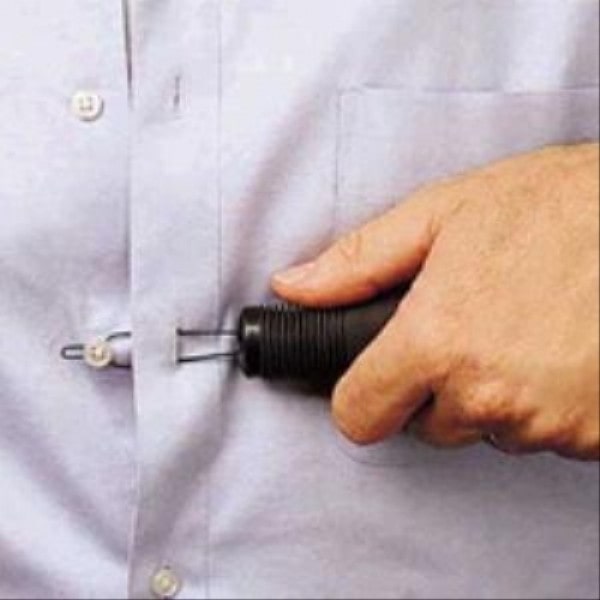 Buttonhooks were made in a variety of designs. One common design was a handle similar in shape to a knife handle into which a steel hook on a long slender shaft was inserted. To use the implement on a shoe, one firmly grasped the handle, and then inserted the steel hook through the eyelet, grasping the button and pulling it through. Unfortunately, aggressive use of the buttonhook often did more harm than good as it could tear the buttonhole or pull out the button. Not only were the shoes and garments damaged: sometimes a straightened out or distorted hook on a buttonhook indicates that the tool was subject to rough or repeated use.
Buttonhooks were made in a variety of designs. One common design was a handle similar in shape to a knife handle into which a steel hook on a long slender shaft was inserted. To use the implement on a shoe, one firmly grasped the handle, and then inserted the steel hook through the eyelet, grasping the button and pulling it through. Unfortunately, aggressive use of the buttonhook often did more harm than good as it could tear the buttonhole or pull out the button. Not only were the shoes and garments damaged: sometimes a straightened out or distorted hook on a buttonhook indicates that the tool was subject to rough or repeated use.Usually, the large, sturdy button hooks were intended for doing up the buttons on boots, whilst the smaller, more dainty ones were for gloves. Button hooks of a foot or more in length, sometimes unkindly called " fat lady hooks", allowed the user to fasten his or her boots without bending over, often not easy when a person was wearing tight-laced corsets, while tiny examples no longer than your little finger were meant to be carried in a purse or waistcoat pocket on the off chance that it might come in handy.
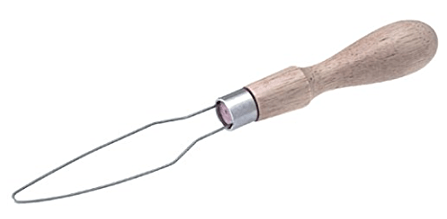 The buttonhook was generally the size of a fork although it ranged in size from less than an inch to around 2 feet in length. Most were used for shoe buttons, spats and gaiters, although the smaller types, "glovehooks", were used for buttons on dresses, sleeves and men's stiff collars. Many glovehooks have a small ring on the handle end. This was for a lady to attach the item to her chatelaine at her belt, or on a necklace. Some of the folding glove hooks were bow style or penknife style also had rings that could be affixed to a watch chain as a fob.
The buttonhook was generally the size of a fork although it ranged in size from less than an inch to around 2 feet in length. Most were used for shoe buttons, spats and gaiters, although the smaller types, "glovehooks", were used for buttons on dresses, sleeves and men's stiff collars. Many glovehooks have a small ring on the handle end. This was for a lady to attach the item to her chatelaine at her belt, or on a necklace. Some of the folding glove hooks were bow style or penknife style also had rings that could be affixed to a watch chain as a fob.Because of their relationship with shoes, many buttonhooks have shoehorn-shaped handles. Another variation was the folding buttonhook, made in both steel and silver and in varying sizes - some look big enough to take stones out of horses' hooves, whilst others, usually in silver, tiny and delicate enough for the most minute of button - which are more expensive.
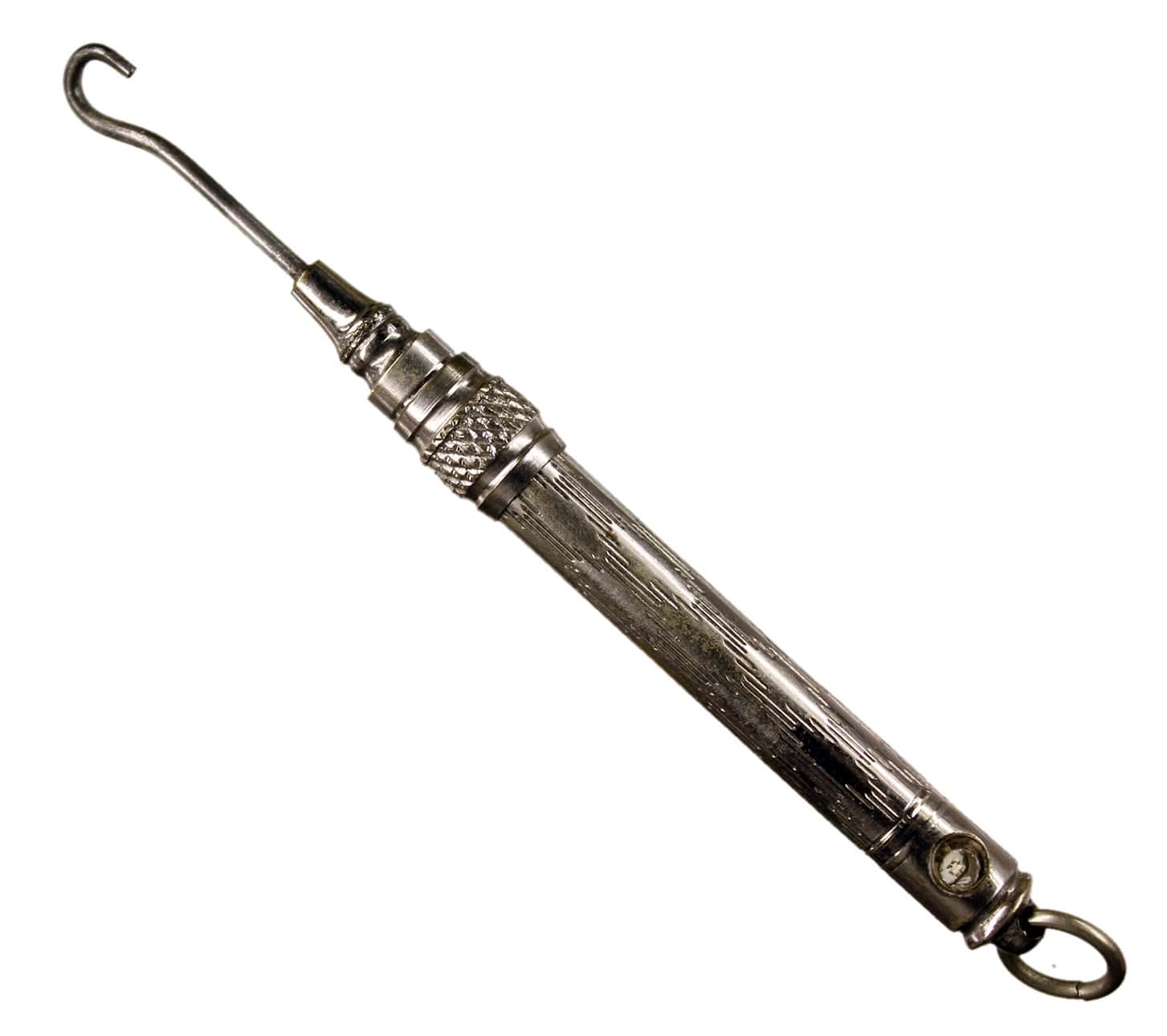 In some cases the buttonhook is designed with a loop instead of a hook, but it performs the same function. The loop hooks were often associated with the use on a man's starched collar - and simple steel advertising loop style hooks were sold as "collar buttoners". Some of these hooks advertised collars or laundry starch.
In some cases the buttonhook is designed with a loop instead of a hook, but it performs the same function. The loop hooks were often associated with the use on a man's starched collar - and simple steel advertising loop style hooks were sold as "collar buttoners". Some of these hooks advertised collars or laundry starch.Buttonhooks were purchased individually for specific purposes, but as people became more affluent and travelled more frequently, retailers made it a common practice to include a buttonhook in such things as cased dressing table sets, travelling sets, and the kits for manicure and shaving.
Although buttonhooks were in existence through the 1600s and 1700s among the upper classes, buttonhooks prior to the industrial revolution are rarely found today. Unless they were made of a fine material such as gold or silver, they may have been discarded. There are still a few examples of early to mid 1800s wooden buttonhooks with elaborately turned handles. Most appeared when the feminine high buttoned boot became popular in the 1880s. Previously, ladies' boots were made of soft leather, but a new fashion demanded stiff leather boots that would fit tightly and show off the shape of the ankle. New industrial developments such as the invention of a machine that could sew buttonholes led to the increased production of boots with rows of tiny buttons. The growing middle classes were an important market for these fashions. By the 1880s, gloves and garments began to feature more buttons, especially long rows of buttons on the front or back of a dress, or on a pair of long gloves. All of these factors resulted in an increased demand for buttonhooks.
Materials
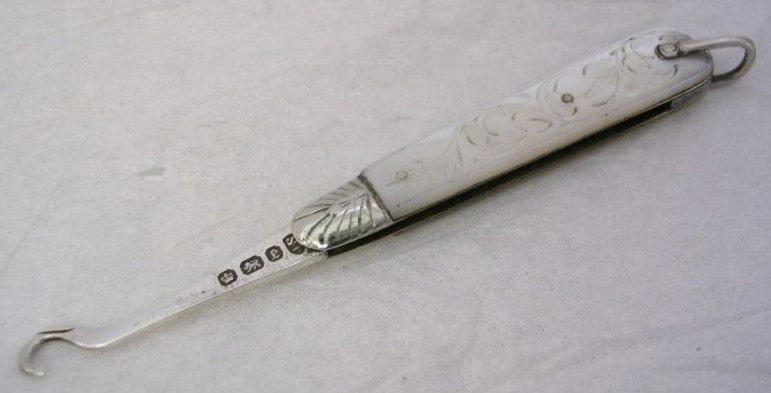 Since buttonhooks were in common use across every class in society, they can be found in all manner of materials, from wood, gold and silver, brass, bone, ivory, tortoiseshell, mother-of-pearl, and latterly rubber and celluloid.
Since buttonhooks were in common use across every class in society, they can be found in all manner of materials, from wood, gold and silver, brass, bone, ivory, tortoiseshell, mother-of-pearl, and latterly rubber and celluloid.The impact of the first World War led to less restrictive clothing as many women joined the workforce as a part of the war effort. However, button boots, buttoned gloves and spats continued to be worn through the war years and buttonhooks were still produced during the 1920s and 1930s. Men's spats were usually in dark colours or white, while women's spats at that time came in colours to compliment their garments. Children's leather boots still continued to have buttons in the 1920s as it was thought that the tight leather strengthened the ankles.
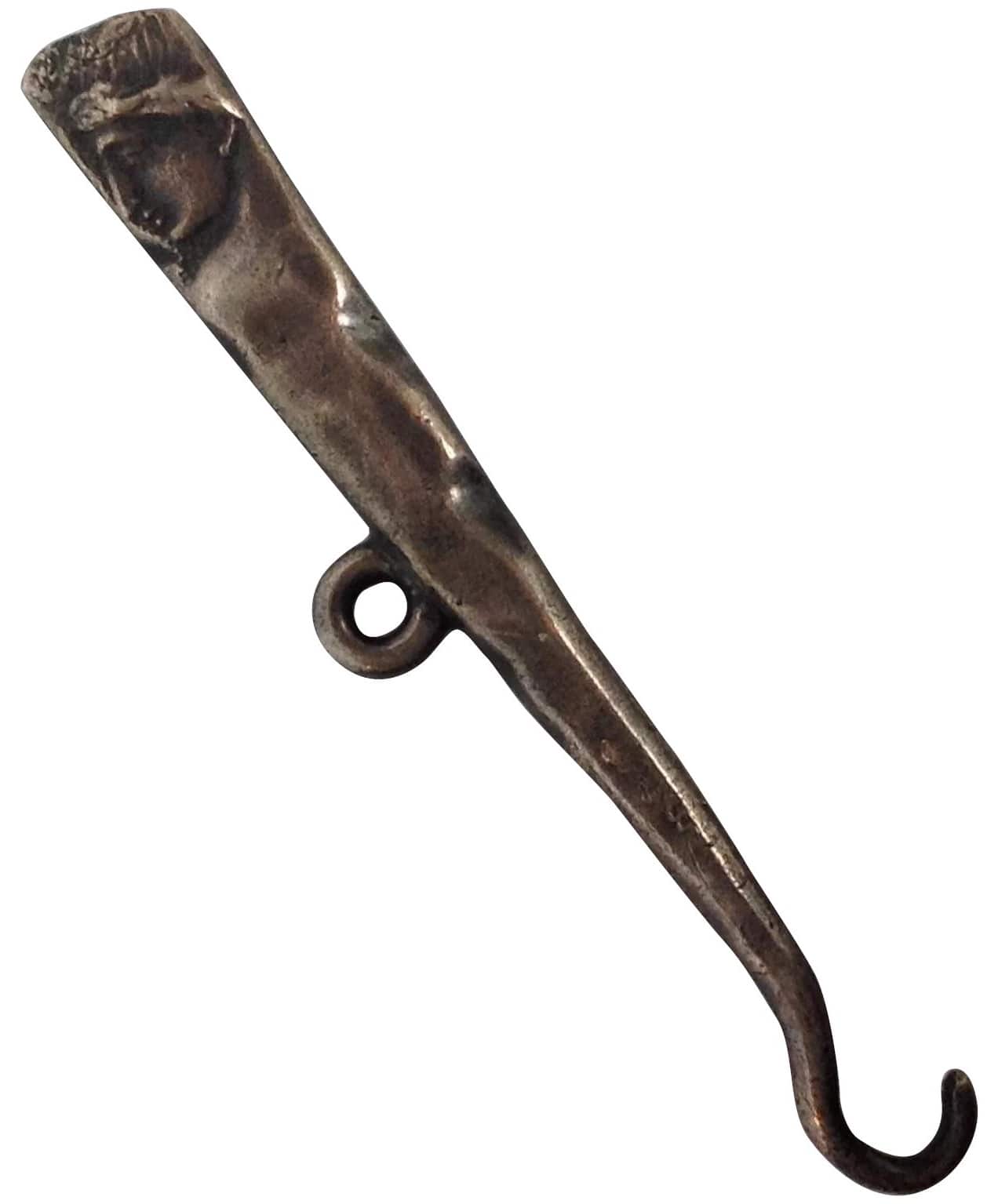 The most common buttonhook materials at that time were early plastics such as celluloid, bakelite, french ivory, and marbled plastics. Handles were produced to resemble tortoiseshell, amber and ivory. Today many are still fooled by the "French ivory" mark - actually plastic. Maker marks include Dupont, Pyralin Ivory, etc. Figural plastics were made in the United States. Two types are commonly seen: the Jockey and the Leg in Buttoned Boot. These came in a number of colours such as turquoise, fuchsia, red, ivory, and also in marbled multi-coloured plastic. Another plastic figural has a horse head.
The most common buttonhook materials at that time were early plastics such as celluloid, bakelite, french ivory, and marbled plastics. Handles were produced to resemble tortoiseshell, amber and ivory. Today many are still fooled by the "French ivory" mark - actually plastic. Maker marks include Dupont, Pyralin Ivory, etc. Figural plastics were made in the United States. Two types are commonly seen: the Jockey and the Leg in Buttoned Boot. These came in a number of colours such as turquoise, fuchsia, red, ivory, and also in marbled multi-coloured plastic. Another plastic figural has a horse head.Sterling silver buttonhooks may be found in a number of patterns. There were handles shaped as animal heads, popular characters, and cherubs. Many had a repousse floral pattern. Most British sterling buttonhooks were assayed in Birmingham, UK and usually include their maker's mark and date mark. Other assay offices included London, Sheffield, and Chester. Well-known and prolific British makers included Adie & Lovekin, Levi & Salaman, Goldsmiths & Silversmiths Co, and Crisford & Norris. These are only a few of the hundreds of British makers who applied their own maker's marks to their wares. William Comyns was a notable British designer from the Victorian era, and Liberty & Co. produced distinctive stylized Art Nouveau buttonhook designs.
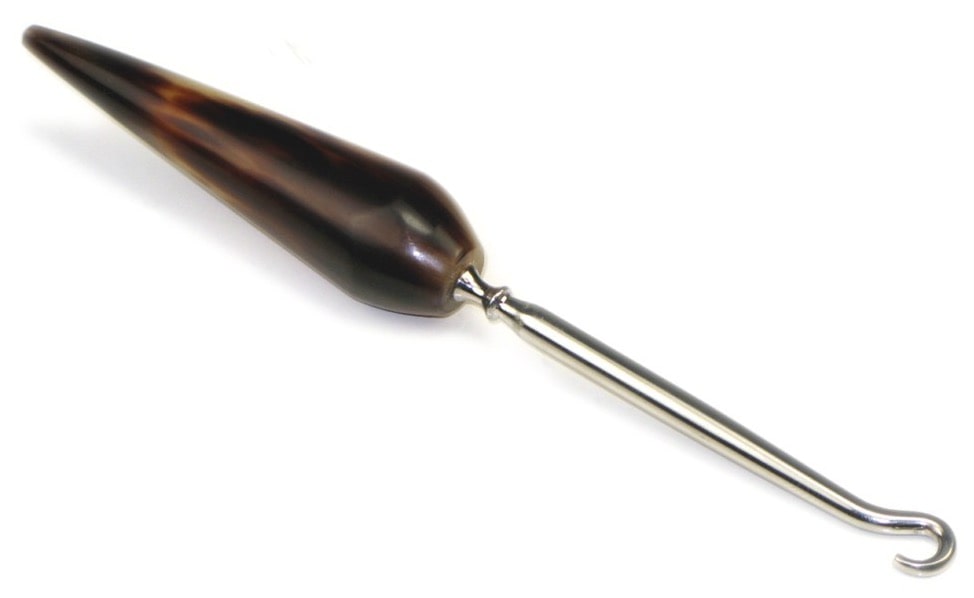 American sterling silver buttonhooks were often marked with just "Sterling" and no indication of a maker. However, some were marked - these included Gorham, Tiffany, Foster & Bailey (Rhode Island), Whiting, Kirk (Baltimore), Shiebler, Lapierre, and Unger Brothers. Shiebler sterling is famous worldwide and his buttonhooks featured unique Art Nouveau natural forms.
American sterling silver buttonhooks were often marked with just "Sterling" and no indication of a maker. However, some were marked - these included Gorham, Tiffany, Foster & Bailey (Rhode Island), Whiting, Kirk (Baltimore), Shiebler, Lapierre, and Unger Brothers. Shiebler sterling is famous worldwide and his buttonhooks featured unique Art Nouveau natural forms.Sterling silver buttonhooks continued to be made - although the designs were streamlined to reflect the Art Deco aesthetic. By the late 1920s footwear no longer had quite as many buttons and pumps were commonly worn, but the buttonhook continued to be used in rural areas where styles didn't change as quickly. The trend was toward garments which required minimal maintenance and allowed easy movement. Flapper's shoes often had just one button to fasten. In addition, the invention of the zipper accelerated the decline in use of the buttonhook. A modern version of the buttonhook is still sold today and designed to aid dressing for individuals with physical disabilities.
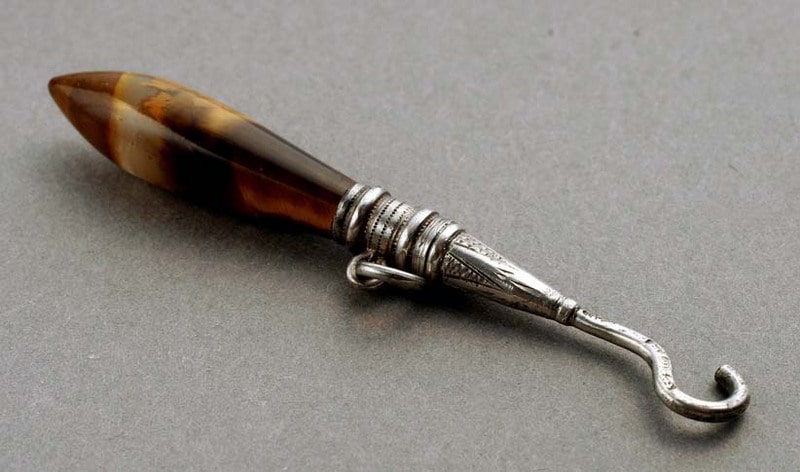 The range of materials used for buttonhook construction was not limited to sterling silver. Natural materials were also used such as mother-of-pearl, antler, ivory, jet, bone, wood, tortoiseshell or abalone shell. Other metals used include brass, german silver, aluminium, nickel plated steel, sterling and gold. American sterling silver hooks are often decorated with inlaid amethyst, garnet or turquoise. Some hooks of British origin feature handles completely made of cornelian, amethyst, moss agate, or onyx. Some of these have a sterling silver ferrule and other fittings. Another category is brass with stone - these included figural handles with a stone ball incorporated within the design. One type was a thistle with a coloured agate ball and a brass finial.
The range of materials used for buttonhook construction was not limited to sterling silver. Natural materials were also used such as mother-of-pearl, antler, ivory, jet, bone, wood, tortoiseshell or abalone shell. Other metals used include brass, german silver, aluminium, nickel plated steel, sterling and gold. American sterling silver hooks are often decorated with inlaid amethyst, garnet or turquoise. Some hooks of British origin feature handles completely made of cornelian, amethyst, moss agate, or onyx. Some of these have a sterling silver ferrule and other fittings. Another category is brass with stone - these included figural handles with a stone ball incorporated within the design. One type was a thistle with a coloured agate ball and a brass finial. Trench Art
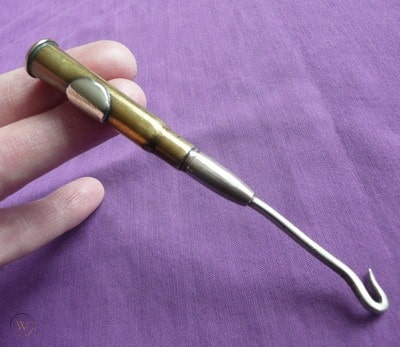 Trench art hooks from World War I were made from salvaged battlefield metal debris. One type utilized the bullet and shell casing as a handle - these items were polished up and welded. In most cases a flattened uniformed button was affixed to the top of the handle, and along the side of the handle. Some are engraved with personal messages and a date as they were given by soldiers as gifts to friends and family. Some are engraved with battles: "Verdun" 1916, or personalized "To Elizabeth from Ross / Vosges 1918" - a site where Americans fought, and also "To my wife Ivah from Sgt. R. G. Foster, Shoreham August 17th, 1917 with Canadian buttons. The last buttonhook hook although customized has appeared in the same shape and size with a Shoreham engraving, suggesting that someone near the camp (possibly a civilian) was making up these buttonhooks and personalizing them for the men passing through. Occasionally this type of buttonhook was further improved upon with elaborate stippled engraving such as was normally found on the larger trench art shell vases. Debate continues whether the items were made by soldiers or by civilians. It may be that the answer is both: soldiers were not always in the trenches, and rotated from "rest camp" in outlying
Trench art hooks from World War I were made from salvaged battlefield metal debris. One type utilized the bullet and shell casing as a handle - these items were polished up and welded. In most cases a flattened uniformed button was affixed to the top of the handle, and along the side of the handle. Some are engraved with personal messages and a date as they were given by soldiers as gifts to friends and family. Some are engraved with battles: "Verdun" 1916, or personalized "To Elizabeth from Ross / Vosges 1918" - a site where Americans fought, and also "To my wife Ivah from Sgt. R. G. Foster, Shoreham August 17th, 1917 with Canadian buttons. The last buttonhook hook although customized has appeared in the same shape and size with a Shoreham engraving, suggesting that someone near the camp (possibly a civilian) was making up these buttonhooks and personalizing them for the men passing through. Occasionally this type of buttonhook was further improved upon with elaborate stippled engraving such as was normally found on the larger trench art shell vases. Debate continues whether the items were made by soldiers or by civilians. It may be that the answer is both: soldiers were not always in the trenches, and rotated from "rest camp" in outlying 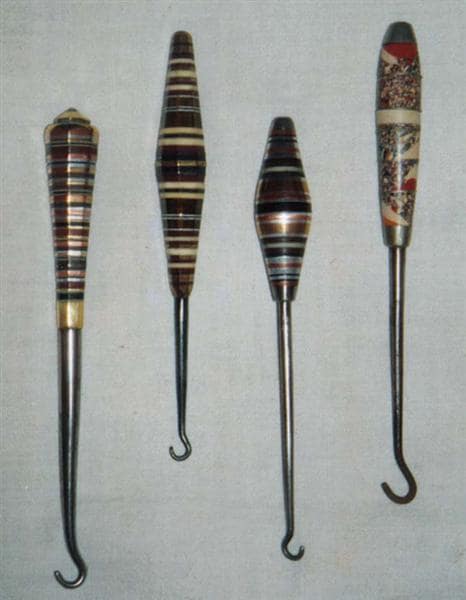 villages. Engineer and service battalions may have had equipment to produce the hooks. However, time was usually limited as rest camp actually involved training and marches. It is clear that after the war civilians produced trench art through the 1920s and 1930s as souvenirs for visitors to the battlefields.
villages. Engineer and service battalions may have had equipment to produce the hooks. However, time was usually limited as rest camp actually involved training and marches. It is clear that after the war civilians produced trench art through the 1920s and 1930s as souvenirs for visitors to the battlefields.Trench art buttonhooks are both charming and thought provoking. The most common were made from decommissioned 0.303 bullets and drilled through from base to tip to accommodate the hooked prong. Tradition has it that these were made by bored Tommies with nothing better to do with their time whilst at the Front. True or not it makes a good story, but in reality many were probably made in small workshops for soldiers to buy and send home to their loved ones.
Another type of hook falling under the "trench art" label and probably appearing from the war period to as late as the 1940s was the "washer" hook. This hook was hand assembled with rings of plastics and various metals, and then polished smooth. These may have been made both by soldiers, and by civilians. Most examples have plastics in rust, ivory, and dark colours, but occasionally there are examples found with red, turquoise and brighter plastics. Some have a metal finial which has been elaborately turned and shaped.
Advertising
 Generally speaking, advertising buttonhooks are amongst the most simple found and were mass produced in large numbers, that could then be ordered by a manufacturer or retailer and over stamped with his name or product or logo.
Generally speaking, advertising buttonhooks are amongst the most simple found and were mass produced in large numbers, that could then be ordered by a manufacturer or retailer and over stamped with his name or product or logo.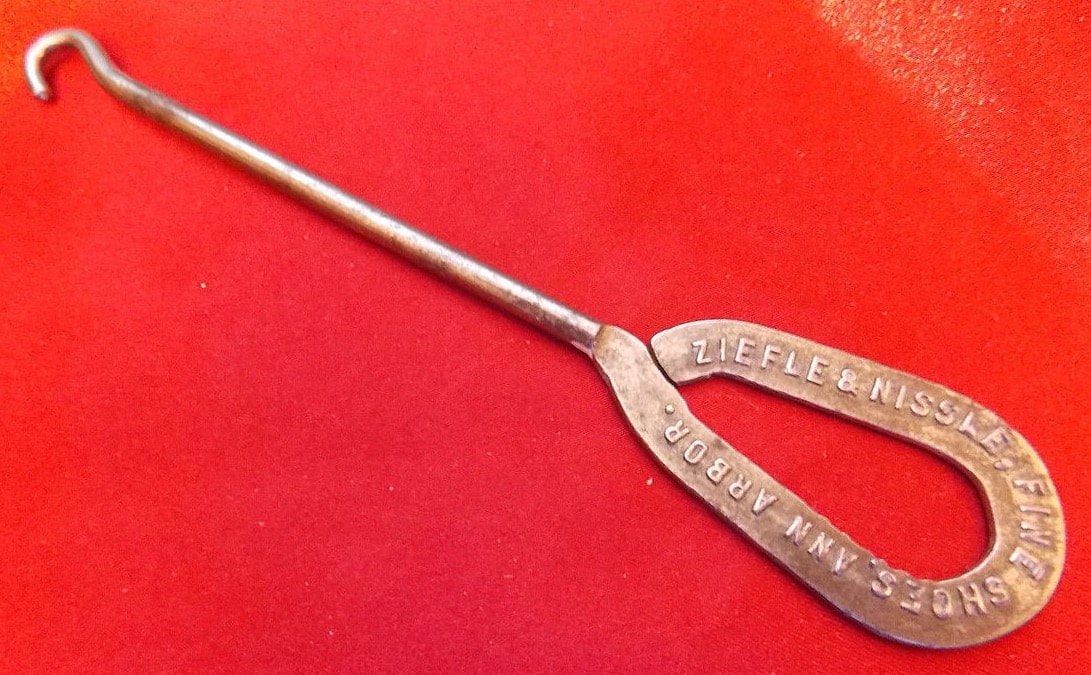 Many advertising buttonhooks were purchased from manufacturers who stamped the name and address of the business on the hook's handle. The merchant then distributed the hooks to his customers, usually at no charge. The buttonhook was formed from a piece of wire, with a looped handle flattened and pressed with the advertising information. Handle shapes varied - many were in the shape of a ring, a peanut, a teardrop or a loop. There were also advertising collar buttoners with a loop instead of a hook. The advertising went on the straight handle. A more elaborate type was moulded with a standard floral pattern and included a promotional slogan and better description of the goods for sale. These buttonhooks mainly appeared in the U.S., Canada, United Kingdom, and Germany. Most bear an 1895 patent date and are nickel plated steel. Generally speaking, advertising buttonhooks are amongst the most simple found and were mass produced in large numbers, that could then be ordered by a manufacturer or retailer and over stamped with his name or product or logo. The most unusual advertising hooks have handles which are celluloid pinbacks manufactured in New Jersey by Whitehead & Hoag. The circular celluloid button has usually had a colourful advertising illustration. Buttonhooks were made for companies such as Keen's Mustard, Sanford & Chase Coffee.
Many advertising buttonhooks were purchased from manufacturers who stamped the name and address of the business on the hook's handle. The merchant then distributed the hooks to his customers, usually at no charge. The buttonhook was formed from a piece of wire, with a looped handle flattened and pressed with the advertising information. Handle shapes varied - many were in the shape of a ring, a peanut, a teardrop or a loop. There were also advertising collar buttoners with a loop instead of a hook. The advertising went on the straight handle. A more elaborate type was moulded with a standard floral pattern and included a promotional slogan and better description of the goods for sale. These buttonhooks mainly appeared in the U.S., Canada, United Kingdom, and Germany. Most bear an 1895 patent date and are nickel plated steel. Generally speaking, advertising buttonhooks are amongst the most simple found and were mass produced in large numbers, that could then be ordered by a manufacturer or retailer and over stamped with his name or product or logo. The most unusual advertising hooks have handles which are celluloid pinbacks manufactured in New Jersey by Whitehead & Hoag. The circular celluloid button has usually had a colourful advertising illustration. Buttonhooks were made for companies such as Keen's Mustard, Sanford & Chase Coffee.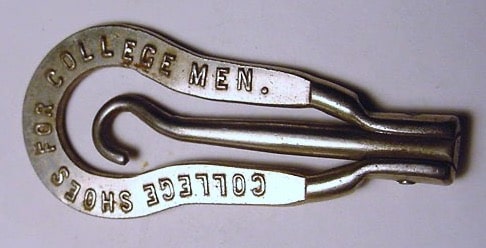
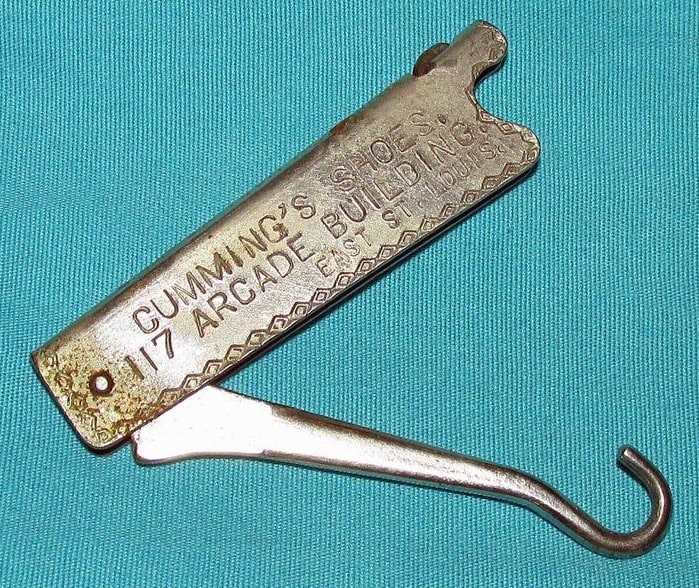
During the Victorian era, button hooks were an important accessory for well-dressed men and women. Ladies used elegant button hooks, often made of sterling and ivory, to fasten the numerous buttons on their elbow-length gloves, and men used hooks for their shoes and spats. This example was probably given away to customers at Frazin & Oppenheim, a shoe company located at the heart of the shopping district known as Ladies' Mile. Original partners Louis Frazin and Abraham M. Oppenheim operated the store together from about 1897 until 1914, when it became the Frazin Shoe Company. The store went out of business in the early 1920s.
Dating
Buttonhooks can usually be dated between 1880 and 1915 and the majority found today date to between 1890 and 1910. The surprising thing about buttonhooks is the variety of designs, sizes and materials utilized in their construction. There was a buttonhook for every taste, from the simple steel wire loop to 9K gold. The Victorian love of invention led to numerous buttonhook patents and attempts to combine the buttonhook with other useful objects such as the curling iron, can opener, tobacco cutter, nail file, shoe horn, scissors, and pen knife. Folding and retractable buttonhooks were also available. A sterling silver model includes a buttonhook on one end and a shoe horn on the other end. The majority of the folding and combined types were inexpensively made in steel, although some were made in sterling silver or finer materials.
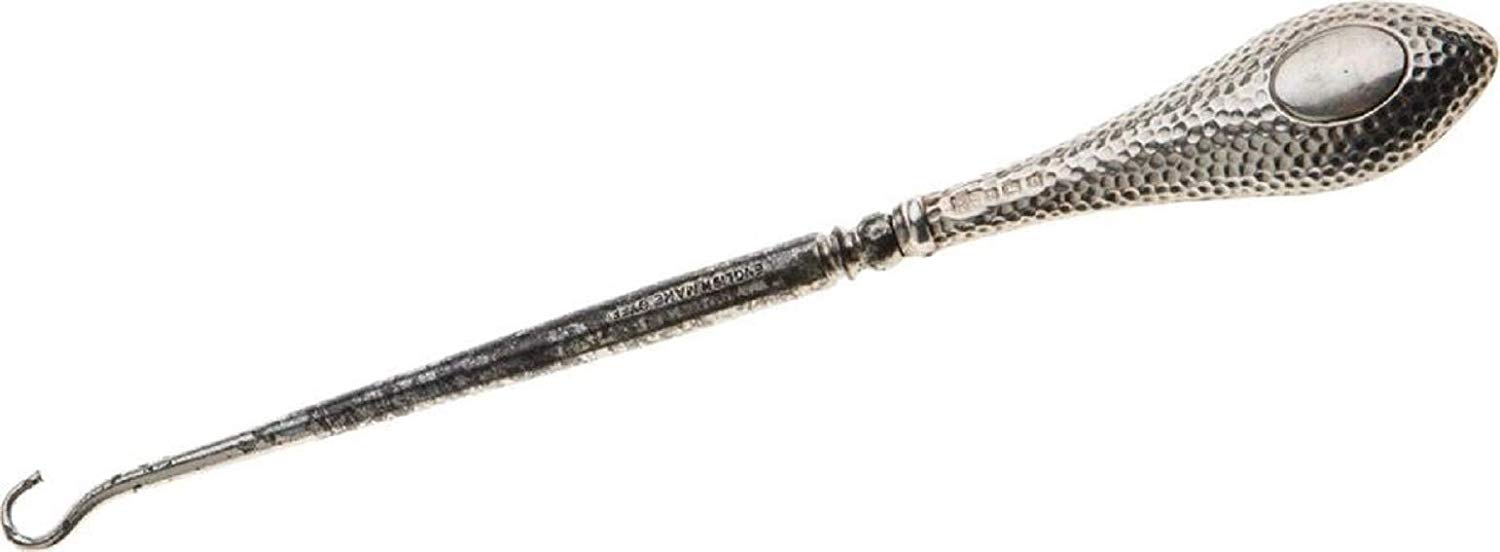
British sterling silver buttonhooks that have a date stamp can be dated precisely.
Displaying
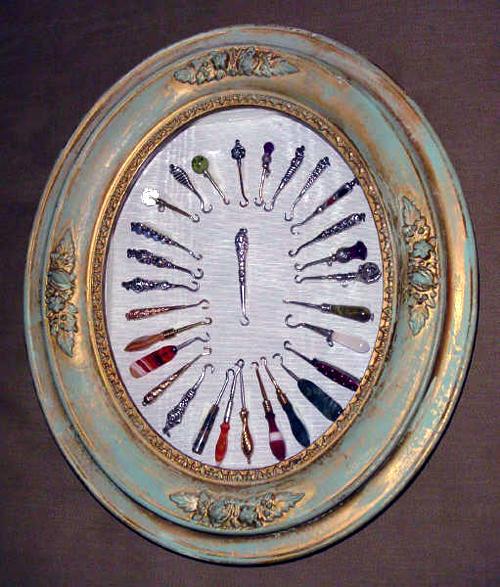 During the Victorian era interest in collecting grew rapidly as the standard of living rose along with mass production and improved transportation. It became easier to travel and this meant that a small souvenir might be brought back from a trip. Expositions of new products became popular and there was a constant hunt for new and improved items, and a demand for a full range of choices. The Victorians not only enjoyed collecting, but they proudly displayed their purchases - we all are familiar with the "what not" shelf and its many knick knacks. The studious displayed scientific collections - rocks, fossils, butterflies. The wealthy collected souvenirs from ancient cultures. And many boasted a collection of picture postcards, stereo views, and prints - all brought out to impress the visitor.
During the Victorian era interest in collecting grew rapidly as the standard of living rose along with mass production and improved transportation. It became easier to travel and this meant that a small souvenir might be brought back from a trip. Expositions of new products became popular and there was a constant hunt for new and improved items, and a demand for a full range of choices. The Victorians not only enjoyed collecting, but they proudly displayed their purchases - we all are familiar with the "what not" shelf and its many knick knacks. The studious displayed scientific collections - rocks, fossils, butterflies. The wealthy collected souvenirs from ancient cultures. And many boasted a collection of picture postcards, stereo views, and prints - all brought out to impress the visitor.Display was crucial, since an important component of collecting for the Victorians was to be able to impress others with their taste and learning. Objects acquired a social significance of their own as rigid Victorian social codes were extended to the realm of collecting and display. Housekeeping manuals of the time gave specific instructions for the proper display of a wide variety of items. In 1882, Oscar Wilde went on an American lecture tour to advise on home decoration down to the smallest detail, including the correct height for hanging pictures. In his famous work The Picture of Dorian Grey (1890), the main character was a collector whose every mood is played against his luxurious surroundings. In one scene, he studies the large bill for his antique silver toilet set, and comments that "...we live in an age when unnecessary things are our only necessities." In the end, when the contents of his Art Nouveau style home were auctioned off, Wilde sat in jail and wrote that combined with the death of his mother and the betrayal of his friend, the loss of his carefully collected books and china was a terrible moment.
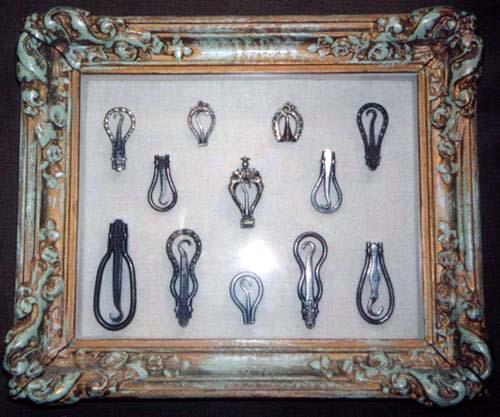 Today, one thing to consider from an aesthetic point of view is that it can be overwhelming for someone who does not share your passion for a collection to see a display of hundreds (or even thousands) of items assembled together in one room. Keeping this in mind, you may want to highlight selected items or themes from your collection and store the balance. Group your collections in clearly defined areas to retain their impact within the interior decor. If you have tall bookshelves, use one or two of the shelves to display a small collection. Circa 1915 book cabinets with glass doors provide excellent display opportunities. Old store displays can often be found at antique shows, and these can create effective displays.
Today, one thing to consider from an aesthetic point of view is that it can be overwhelming for someone who does not share your passion for a collection to see a display of hundreds (or even thousands) of items assembled together in one room. Keeping this in mind, you may want to highlight selected items or themes from your collection and store the balance. Group your collections in clearly defined areas to retain their impact within the interior decor. If you have tall bookshelves, use one or two of the shelves to display a small collection. Circa 1915 book cabinets with glass doors provide excellent display opportunities. Old store displays can often be found at antique shows, and these can create effective displays.In the case of an implement such as the buttonhook it is important to provide clear explanations as to the buttonhook's origins and use since most visitors will not recall using or seeing the tool in their lifetime. Most showcase displays will include a vintage buttoned boot, a lady's glove with many buttons, some early advertising pieces such as shoe store trade cards, and other related items.
Such a display also functions well when there are several levels. This effect may be created by fashioning special fabric covered boxes (everything in the same colour) so one might raise some of the items. Any type of box may be utilized – seek out a variety of shapes. The box may be "gift-wrapped" utilizing a glue gun. Suitable fabrics include velvet or moire satin, in solid colours.
Finally – in some cases the descriptions could be specially mounted on foam core so that they may be raised and clearly visible to someone looking into the showcase through glass. Also, some of the original postcards and early advertising pieces might be very small when viewed through glass and at a distance. These might be enlarged on a colour copier and mounted on foam core and placed at the back of the display.
Shadow Box
Items of modest proportions and weight can be displayed and protected in a shadow box. This display unit is something like a picture frame, but with a deep space behind the glass. Shadow boxes can be custom made at framing shops or purchased in standard sizes at craft stores. Since collections are generally growing, a permanent method of attaching items to a display can create problems when you acquire a new addition. Instead, select a few spectacular examples or a specific theme for your permanent shadow box display.
Recent Trends
Whimsical shadow boxes as art are a current trend in the modern art world. This has its origins in the 1960s when collage like displays were made with a variety of items. The boxes are usually open shallow wooden boxes with subdivisions, similar to a wall mounted old printing box (the type that held the letters). There is no glass and all items are firmly glued in. Some consist of a variety of old items such as keys, small glass tubes, glass tubes filled with different coloured beads, letters, old photos, and postage stamps. They differ from the tacky popular type shadow box as there is no attempt to "prettify" with lace, glitter, glass jewels, feathers, etc. The display also has a theme – usually the artist has written lines of poetry, and then affixed these among the items. The contents of the box are not entirely vintage - in many cases the artist has assembled or reproduced vintage items - staining letters, and making labels for little glass tubes. The finished boxes are mounted on the wall as art. A recent Toronto art gallery display showed these shadow boxes at a price range of $500 and up. Although the idea of permanently gluing items down is not acceptable for a buttonhook collection, these boxes deserve some attention as some of their techniques might be incorporated into a buttonhook display.
Collecting
Collecting buttonhooks is a fascinating, rewarding and inexpensive hobby that takes up very little space and were made in an astonishing variety of shapes and materials. It is for these reasons that make button hooks an ideal collecting area. Serious collectors from around the world belong to The Buttonhook Society established in 1979 in Maidstone, Kent. The society publishes an informative colour magazine called "The Boutonneur" six times a year for members. In addition, the society mounts well-attended yearly exhibitions in locations throughout the United Kingdom. The Buttonhook Society publishes an illustrated Compendium of detailed information on buttonhooks. This has been a most worthy archival project as it catalogues many of the different variations of buttonhooks, and has built a list of all the makers and manufacturers of buttonhooks as well as patents and registration numbers for different buttonhook designs.
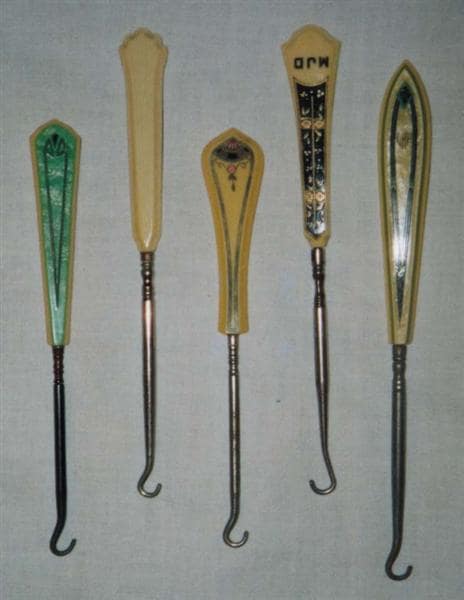 Both British and American manufacturers offered the option of purchasing the buttonhook as a part of a matched dresser set. These sets included a manicure knife, shoe horn, letter opener, cuticle knife, scissors, small bottles, and other items set in a specially fitted case. The number of components in a dresser set varied from just two (usually a buttonhook and a shoehorn) to a dozen or more different tools. Sets were also produced in other materials such as ivory, bone, plastics, faux horn, and abalone shell. The British sterling silver sets generally had a leather case with velvet lining and indentations that held each item safely in place. American sets were often encased in celluloid boxes with decoupaged floral detail. In many cases the sterling sets may be found in excellent condition – indicating their history as a prized gift.
Both British and American manufacturers offered the option of purchasing the buttonhook as a part of a matched dresser set. These sets included a manicure knife, shoe horn, letter opener, cuticle knife, scissors, small bottles, and other items set in a specially fitted case. The number of components in a dresser set varied from just two (usually a buttonhook and a shoehorn) to a dozen or more different tools. Sets were also produced in other materials such as ivory, bone, plastics, faux horn, and abalone shell. The British sterling silver sets generally had a leather case with velvet lining and indentations that held each item safely in place. American sets were often encased in celluloid boxes with decoupaged floral detail. In many cases the sterling sets may be found in excellent condition – indicating their history as a prized gift.The impact of the first World War led to less restrictive clothing as many women joined the workforce as a part of the war effort. However, button boots, buttoned gloves and spats continued to be worn through the war years and buttonhooks were still produced during the 1920s and 1930s. Men's spats were usually in dark colours or white, while women's spats at that time came in colours to compliment their garments. Children's leather boots still continued to have buttons in the 1920s as it was thought that the tight leather strengthened the ankles.
The ubiquitous shoe lace and zip fastener made the button hook redundant. The zip fastener as we know it today, based on interlocking teeth, was invented by an employee of Judson's, Swedish scientist Gideon Sundback in 1913. The Birmingham company Kynoch produced the "Ready Fastener" in 1919, and the term zipper was first coined by the US company B. F. Goodrich in 1923, although it was not until the 1930s that the zip was used on clothes and even then it could not be used on jackets, because it had to be permanently joined at one end.
